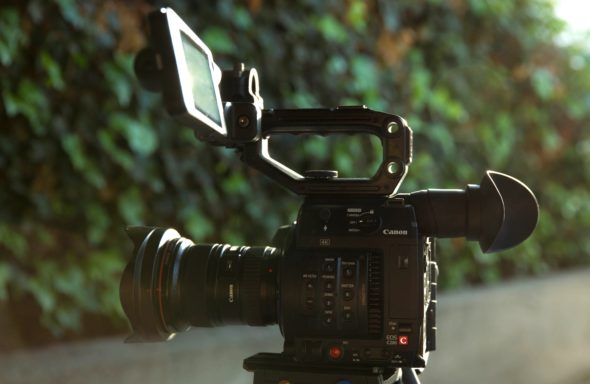
“New filmmakers” is a pretty generic term. When I use it, I’m not referring to young filmmakers but all filmmakers who are new to the industry or still somewhat inexperienced. Not every new cinematographer struggles with the following elements of the movie or filmmaking process, but every filmmaker should pay special attention to them.
Lighting
If you ask practically anyone in the movie- or video-making industry about the most important visual element of production, they should say light. And that answer would be absolutely right. Light is everything! It is the factor that determines image quality as well as the extent of visibility.
However, too many newer and up-and-coming filmmakers skimp out on the regular use of additional studio lights or forgo professional lightingcompletely. They employ natural lighting and rely too heavily upon it. Not only does quality lighting establish the level of crispness and brightness present in a moving image, but it also sets the tone or mood of the setting in which a shot takes place. This, in turn, reflects on the atmosphere of the particular scene.
Filmmakers should consider both the type of lights being used and their strategic placement. For example, dominant lighting should not be situated in such a way that the camera’s shadow is caught on video. Lighting always has a pivotal role to play, and the use of professional lighting equipment is preferable whenever possible.
Lack of Movement
Whether out of fear or a lack of experience, many new filmmakers tend to shoot too many stationary scenes, excluding basic panning, tilting, and dollying. More skillful cinematographers with a larger budget usually employ professional-grade cranes. Even with a single camera set-up, a good tripod able to perform smooth pans and tilts is a bare necessity. Staging only stationary scenes may be fine for an amateur Youtube video, but aspiring videographers should use this technique sparingly.
Stationary scenes ought to be mixed in with scenes displaying a variety ofcam motion. This combination requires careful consideration. In addition to movement on the vertical and horizontal planes, video footage can (when appropriate) involve zoom-ins and zoom-outs. A videographer should not overuse zooms just as he or she shouldn’t overuse any effects or specific camera shots.
Many dramatic action or fighting scenes employ the shaky cam effect. This pretty much necessitates that the video footage be slightly shaky, and the easiest way to achieve this is for the camera operator to hold the camera him or herself instead of stabilizing it. To add additional layers of visual depth, refocus on different subjects while the video cam is recording. In some cases, this is necessary, such as if the main subject is getting closer to or farther away from the camera. But this effect is also used in Hollywood films when the cinematographer wishes to bring the viewer’s attention to a particular character or object, isolating it from a larger group of characters or objects.
Too Much Movement
I know. I just said you need movement to make a production appear more professional, more creative. Still, a filmmaker needs to be aware that an audience also needs some “down time.” Personally, I love action movies, but even among the various fast-paced sequences and shots with abrupt camera motion typical to this genre, there need to be some slow scenes, even stationary ones. All of the best films include a thorough combination of both active and still shots.
Over-the-Shoulder Shot
This is a very, very basic rule in video production. Along with the rule of thirds, an over-the-shoulder shot refers to the positioning of on-screen subjects. It’s mostly used when two or more characters confront or talk to each other in close proximity. Picture a man and a woman who are facing one another, having a conversation and standing several feet apart. While one of them is talking, the camera would be focused on the person who’s speaking. But in that very same scene, in another corner of the frame, the back of the shoulder (and sometimes the head) of the other person who’s listening should appear.
Sometimes, particularly in Westerns, this same style is applied but on different parts of the body. For example, if two shooters confront one another, a cinematographer may capture the scene so that one shooter in the background is fully visible and the hip and holster of the other shooter are seen in the foreground.
Variety of Differently Proportioned Shots
If you’ve ever been unfortunate enough to see The Greatest Story Ever Told (1965), I know what you’ve gone through. Though it had a cast which included such big-name stars as Max Von Sydow, Sidney Poitier, Donald Pleasence, Angela Lansbury, and John Wayne, the lighting and cinematography for this feature were extremely poor. The film overused wide shots in order to play up the majesty and grandeur of its broad landscapes. There weren’t many close-up scenes, making it hard to distinguish some of the characters and the actors playing them.
This goes to show you that even Hollywood directors haven’t always done their best. A good video production involves numerous and diverse shots that vary the positioning of subjects in the frame. In the simplest of terms, there are three main types of camera shots: wide shots (also called long shots), medium shots, and close shots.
Film students don’t usually forget these shot-types, but many do struggle with shooting them in variety. A new cinematographer might easily get into a zone where he or she feels comfortable shooting a particular type of shot, but that’s not what will make a good film. A good film is a mixture in every way: a mixture of visuals, dialogue, music, and other sounds.
**
 John Tuttle is a young Catholic man in love with the arts and media. He’s a writer, photographer, and filmmaker who loves being creative. He rarely doesn’t have his camera in hand. John is the 1st place winner for the youth category of the 2017 SkeenaWild Film Festival. His film analyses have been published by several sites and even by Primordial Magazine. Currently, he’s part of a small team working on producing a feature-length animated film about the Civil War. He can be reached at jptuttleb9@gmail.com.
John Tuttle is a young Catholic man in love with the arts and media. He’s a writer, photographer, and filmmaker who loves being creative. He rarely doesn’t have his camera in hand. John is the 1st place winner for the youth category of the 2017 SkeenaWild Film Festival. His film analyses have been published by several sites and even by Primordial Magazine. Currently, he’s part of a small team working on producing a feature-length animated film about the Civil War. He can be reached at jptuttleb9@gmail.com.